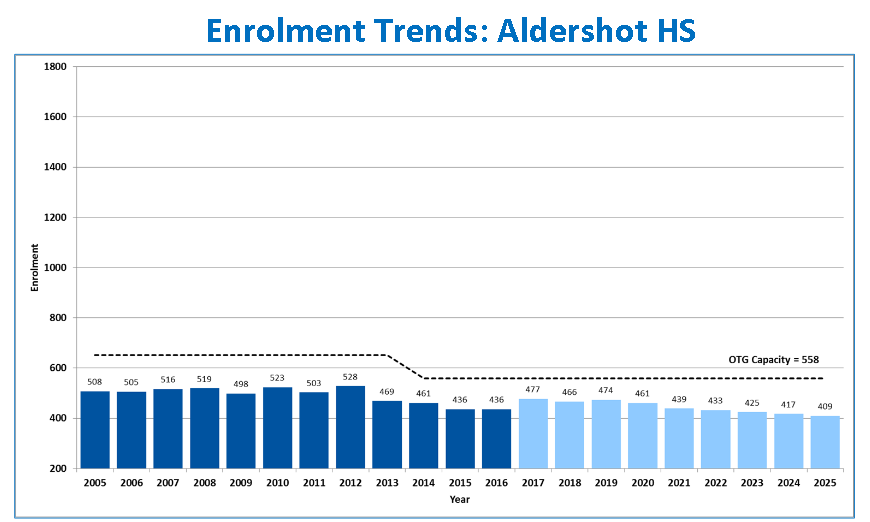 By Pepper Parr
By Pepper Parr
November 3rd, 2016
BURLINGTON, ON
The first two of seven meetings that will take place at each of the high schools in the city were held at Bateman and Nelson.
The Director of Education, Stuart Miller and a number of his staff gave an hour long presentation to six people at the Robert Bateman high school, zipped up their briefcases where they did the presentation a second time to 12 people at Nelson high school.
These meetings were not a required part of the Program Accommodation Review the Board of Education is going through. “It is not an easy time” said Miller

Joey Edwardth, President of Community Development Halton with Director of Education Stuart Miller – she has the data he needs.
Director Miller and the General manager of the Board shared the delivery of the presentation – they were laying out the facts as they understood them.
And the facts are critical.
There are far too many seats in high school classroom that are empty and that just isn’t sustainable.
Miller said the city has one and a half too many high schools – and to make matters worse the capacity the board has it at times in the wrong place.
Unfortunately the Board has known about this for some time. This problem first appeared on their radar screens back in 2013

The city of Burlington doesn’t have a demographer on staff and apparently the Board of Education doesn’t have any of that capacity as well. Community Development Halton (CDH) has a solid team that has the data at its finger tips – but the city and the board don’t seem to know what CDH can do for them. If the problem of falling enrollment was identified in 2012 – it was in the data long before then.
Of more interest to parents is the depth of the problem. Except for Hayden and Nelson high school there is not a high school in the city that is not at some risk.
Set out below is the critical data for every high school – the numbers are not nice and they certainly are not comfortable.
At the first meeting of the Board and the parents at Bateman there were six parents. Bateman is at rick – look at the numbers.
The doted line is the On the Ground capacity of the school.
The critical number is 65% of that OTG. When a school falls below that the Board of education is required to do a Program Accommodation Review.
Each year the Board does an LTAP – Long Term Accommodation study – the quality of those studies may not have been as good as they should have been.

Central has a problem but it is not as bad as Bateman.

How did the demographers miss this one? Add to the problem is the development of a housing project in the north east quadrant of the city.

The sense seems to be that closing Pearson and sending them to Robinson will solve the Robinson problem.

At some point in time the Eaglesfield project will get developed – it looks like that is going to be a family community – will children attend Aldershot?

Bateman would appear to be more at risk than Central.



















But there is already a recommendation on the table, from the Director, to close 2 schools, so don’t expect an obvious possible solution to be seriously researched and reported on. Or any others for that matter.
It appears that the decision is already made.
These people cannot be trusted. They are bean counters with no heart, just rationalizations.
They don’t really represent the children in this debate. What about them? Or are they merely reduced to a problem of surplus pupil spaces, those widgets in warehouse assembly lines that can be shuffled around and/or bussed, at will, like cattle? For their sake, shouldn’t we take a view other than the efficiency one that says that schools that are not completely full represent waste, and should be closed?
This argument is a favourite one of some trustees and other advocates of school closures. It presumes that anything less than 100% utilisation is a waste of taxpayers money (as if everything is always expected to be fully utilised).
We all know that schools have many uses and many values. They are not just for educating the young during the day. It shouldn’t matter that they are not completely full right now – the neighbourhood needs them for the future, which will certainly change, and this change is evident now.
They belong to the residents that fully paid for them, and own them, and the school board holds them in trust. They are a bought and paid for part of the community fabric, the community capital stock, and an asset that has many uses and values, including recreation, sports, social clubs, adult education, clubs, greenspace, heritage, school spirit, memories, diversity of city form and landscape, and the list can go on. They contribute to property values and a sense of the familiar and well-being – the quality of life.
So let’s stop talking about closing schools right off the bat, as a starting opinion, and exhaust ourselves figuring out creative and adaptive ways to reconfigure how we make do and keep what we have.
We will surely need it sometime in the future.
Can some one please explain this to me? If Hayden is over capacity and MM Robinson’s and Person are under. Doesn’t changing the boundary so that students flow into the under capacity schools make more sense than closing them? The 3 schools are very close to each other.
I believe the PAR that is underway will be looking at changing school boundaries to accomplish exactly what you are suggesting.
It looks like MMR can accommodate students from Pearson and some from Hayden, closing one school and better utilizing the remaining two.
I would like to better understand the methodology used to estimate enrollment trends. If the methodology used has been constant for years – just how accurate has it been? If it is new methodology, have they back tested it for accuracy? Hayden is a great example of how the education board can be caught off guard. The school has been open for just four years and it was over-capacity in year three. I recall that John T Tuck and Lakeshore were on the cutting block 10-15 years ago – yet they are both now exceed 100% OTG.